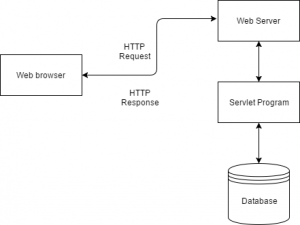
Web development requires handling HTTP requests and responses, and Java Servlets are an effective solution for handling this important component. Web servers can now handle incoming requests and produce dynamic responses thanks to servlets, which are server-side components. We will explore the fundamentals of using HTTP in the context of Java Servlets in this post.
You can opt for Java training course in Lucknow, Pune Noida and other parts of India. A solid understanding of the nuances of HTTP requests, including various methods and headers, is essential for developing servlets efficiently. We’ll look into how servlets help process client requests and generate relevant responses with their lifecycle and specialized objects like HttpServletRequest and HttpServletResponse. Through this investigation, developers will learn more about the fundamental processes underpinning Java dynamic web apps.
Understanding HTTP Requests
It is important to understand the fundamentals of HTTP (Hypertext Transfer Protocol) and request structure before delving into Java Servlets. HTTP is a stateless protocol that facilitates communication between servers and clients, most commonly web browsers. When a client makes an HTTP request, it sends information to the server through a request method, headers, and, optionally, a message body.
Request Methods
HTTP defines a number of different request methods, each with a distinct function. The most popular techniques consist of:
- GET: Requests data from a specified resource.
- POST: Submits data to be processed to a specified resource.
- PUT: Updates a resource or creates a new one if it does not exist.
- DELETE: Requests the removal of a specified resource.
These methods indicate the type of action the client wants to perform on the server.
Request Headers
Additional information about the request, including the client, the type of material being delivered, and the acceptable answer formats, are provided by the headers included in HTTP requests. Some common headers include:
- Host: Specifies the domain name of the server.
- User-Agent: Identifies the client making the request.
- Content-Type: Defines the type of data in the request body (applicable for POST and PUT requests).
Message Body
Certain HTTP requests include a message body containing data provided to the server. This often happens in POST and PUT requests when uploading files or submitting form data.
Java Servlets and Handling Requests
Java Servlets are server-side add-ons that increase a web server’s capacity to provide dynamic content. Servlets are an essential component of Java-based online applications because they manage HTTP requests and provide responses. The javax. servlet package provides classes and interfaces for servlet development.
Servlet Lifecycle
There are three primary stages in a servlet’s lifecycle:
- Initialization: The servlet is loaded and initialized by the servlet container.
- Service: The servlet handles requests by implementing the service method. This method is called by the container for each incoming request.
- Destruction: When the servlet is no longer needed, it undergoes destruction, and the destroy method is subsequently called.
HttpServletRequest
The HttpServletRequest object represents the client’s request to the server. It offers ways to get data back, including request URIs, headers, and arguments. This object is used by servlets to get information about incoming requests.
Retrieving Request Parameters
Depending on the request type, parameters may be supplied in the message body or the request URL. Servlets can retrieve these arguments via the HttpServletRequest object.
HttpServletResponse
The response that the servlet sends to the client is represented by the HttpServletResponse object. It offers ways to write to the response body, control cookies, and set response headers.
- Setting Response Headers
Servlets can provide the client with more information or regulate how the response is handled by setting different headers in the response.
- Writing to the Response Body
To write material to the response body, Servlets use the PrintWriter or ServletOutputStream that they can get from the HttpServletResponse object.
Servlet Mapping
Handling Different Request Methods
By implementing the proper doXXX methods, servlets may handle a variety of request methods. For instance, a servlet would implement the doPost method to handle a POST request.
Best Practices for Servlet Development
Adhering to best practices guarantees scalability, security, and maintainability in servlet programming.
1. Separation of Concerns
Implementing the separation of concerns approach not only facilitates efficient code organization and maintenance but also ensures a streamlined development process. Servlets should focus on processing requests and generating responses, delegating the handling of business logic to other classes or components.
2. Use of Design Patterns
Effectively structuring web applications involves implementing design patterns, with particular emphasis on the Model-View-Controller (MVC) pattern. This enhances code organization and facilitates maintenance. The MVC pattern divides the program into three parts: the view, responsible for presenting data and business logic; the controller, managing user input and modifying the model; and the model, which represents the application’s data and business logic. This approach promotes a clearer separation of concerns and facilitates a more organized and maintainable architecture for web development.
3. Exception Handling
Robust servlets require proper exception handling. Ensuring graceful handling of failures and catching/ managing exceptions enhances user experience by preventing unwanted behavior.
4. Security Considerations
When it comes to web development, security is the top priority. Servlets ought to incorporate authentication and authorization procedures, validate user input, and steer clear of security flaws like SQL injection and cross-site scripting (XSS).
5. Thread Safety
Servlets must prioritize thread safety, especially when concurrently processing requests. It is imperative to ensure that request-specific data avoids storage in instance variables. Storing request-specific data in instance variables risks data corruption in a multi-threaded environment. Instead, opt for local variables or synchronize resource access for a more secure approach.
Conclusion
In conclusion, developing reliable and dynamic web applications requires a solid understanding of how to use Java Servlets for managing HTTP requests and responses. With a thorough grasp of the HttpServletRequest, HttpServletResponse, and servlet lifecycle, developers can effectively handle client requests and create customized responses. Best practices, including separating concerns, adhering to design patterns, and meticulously considering security, facilitate the development of scalable and secure applications with servlet technology.
In the ever-evolving landscape of contemporary frameworks, a fundamental grasp of Java Servlets remains crucial. As technology continues its rapid advancement, developers now have the opportunity to craft web applications that not only exhibit responsiveness and efficiency but also adhere meticulously to industry best practices for security, thereby ensuring maintainability. This solid understanding of servlet development complexities empowers developers to navigate evolving technologies seamlessly, ensuring the creation of robust and future-proof web solutions. The process of using Java Servlets to handle HTTP requests and answers paves the way for effective, high-performance applications and provides access to a better grasp of web development.



